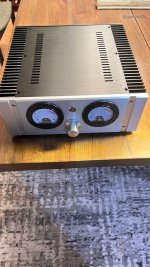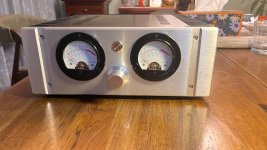Thanks! I know it’s not cheap, but I’m not making a single penny from this small production run due to several factors:
- To ensure optimal digital signal integrity, the PCB stack utilizes high-frequency materials and filled vias.
- To support higher currents, the PCB features 2-ounce copper on the outer layers and 1-ounce copper on the inner layers.
- A 6-layer PCB is used to minimize high-current loop areas and reduce interference.
- Critical components in the signal path include high-precision 0.1% metal film resistors and 1% NP0 capacitors—both costly but essential for performance.
- High-performance, wide-bandwidth differential op-amps and low-latency, high-speed comparators are used, which are not cheap.
- All capacitors are at least X7R grade with low ESR.
- The CNC-machined aluminum case further adds to the cost.
- The most significant factor is the extremely high overhead cost due to the small production volume.
Hi folks,
I'm adding some offline orders from my friends and planning to start the next batch of modules in two weeks. If anyone on the buy list changes their mind during this time, please let me know.
Due to the lifespan management of the NiGa FET, the factory has suggested switching to a different one. The new FET offers better performance.
With this improvement, I aim to translate it into an audible experience enhancement. More details will be discussed in the technical thread later on. Stay tuned!
Thanks!
I'm adding some offline orders from my friends and planning to start the next batch of modules in two weeks. If anyone on the buy list changes their mind during this time, please let me know.
Due to the lifespan management of the NiGa FET, the factory has suggested switching to a different one. The new FET offers better performance.
With this improvement, I aim to translate it into an audible experience enhancement. More details will be discussed in the technical thread later on. Stay tuned!
Thanks!
sorry for the typo, it GaN FET.Due to the lifespan management of the NiGa FET
My experience with GaN FETs in audio is that they can fail in a spectacular fashion as so much current density flows through them. They literally go supernova. I am not sure there is much benefit to GaN FETs for normal audio Class D switching given their fragility compared to robust Si devices.
A lot of Class D brands use them with excellent results. Orchard Audio, Peachtree, Java Audio, Atma-Sphere, AGD to name a few all use GaN Fets and although it is relatively new compared to Si devices, GaN is there to stay. Just look at how much more efficient they are in PSU, high power small packages, the technology will just get better with time.
Do
Do
It's true that ensuring the reliability of GaN FETs under high current density can be more challenging compared to Si MOSFETs, particularly in high-power audio applications where thermal management, gate driving, and protection circuits play a crucial role. If these aspects are not properly optimized, GaN FETs can indeed be vulnerable to failure under transient overload conditions. However, as @pinnocchio mentioned, many manufacturers have successfully implemented GaN FETs in Class D amplifiers with excellent reliability and performance.
Compared to Si MOSFETs, GaN offers faster switching speeds, shorter dead time, and lower parasitic capacitance, resulting in lower switching losses, higher efficiency, and improved high-frequency response. For high-end audio applications, these characteristics help reduce distortion, enhance transient response, and improve overall clarity and detail in sound reproduction.
Of course, GaN technology is still evolving, and its reliability continues to improve. I believe it is already well-suited for most applications, including RF, power supplies, and Class D amplifiers.
When it comes to audio amplifiers, a well-designed circuit—featuring optimized gate drive signals, proper thermal management—can fully harness the advantages of GaN while ensuring long-term stability.
Looking at market trends, GaN FETs are increasingly being adopted by high-end audio brands, highlighting their growing potential and long-term viability in the industry.
@xrk971 If you have any further technical discussions, let's continue in the dedicated technical thread.
Compared to Si MOSFETs, GaN offers faster switching speeds, shorter dead time, and lower parasitic capacitance, resulting in lower switching losses, higher efficiency, and improved high-frequency response. For high-end audio applications, these characteristics help reduce distortion, enhance transient response, and improve overall clarity and detail in sound reproduction.
Of course, GaN technology is still evolving, and its reliability continues to improve. I believe it is already well-suited for most applications, including RF, power supplies, and Class D amplifiers.
When it comes to audio amplifiers, a well-designed circuit—featuring optimized gate drive signals, proper thermal management—can fully harness the advantages of GaN while ensuring long-term stability.
Looking at market trends, GaN FETs are increasingly being adopted by high-end audio brands, highlighting their growing potential and long-term viability in the industry.
@xrk971 If you have any further technical discussions, let's continue in the dedicated technical thread.
Just copy the group buy list in here:
1, Ricardxgf, (2 units)
2, Extreme_Boky, (2 units)
3, Uptownsquash, (2 units)
4, KaffiMann, (2 units)
5, Pinnocchio, (2 units)
1, Ricardxgf, (2 units)
2, Extreme_Boky, (2 units)
3, Uptownsquash, (2 units)
4, KaffiMann, (2 units)
5, Pinnocchio, (2 units)
Please count me in. I am building an audio system and would like two modules for my new amplifier. I hope it's not too late to sign up. Thank you!
Thanks for your interest! The group buy list is still open and will close this weekend as I prepare to start the next round of manufacturing.I hope it's not too late to sign up. Thank you!
Hi folks,
The second round of AMP production has officially begun. Here are the key milestones:
This version of the board features upgraded high-end, thin-film capacitors to enhance performance. please refer to the picture of PCB design below.


The second round of AMP production has officially begun. Here are the key milestones:
- Special Parts Procurement: The order for special components has already been placed, and it will take approximately two weeks for them to arrive at the manufacturer’s warehouse. The aluminum housing order has also been placed.
- PCB & PCBA Production: Once all components are in stock, the PCB and PCBA will be shipped to me within two weeks.
- Board Bring-Up & Testing: It will take an additional 2–3 weeks for board bring-up, testing, and final assembly.
- Shipping: The AMP modules will be shipped to you.
This version of the board features upgraded high-end, thin-film capacitors to enhance performance. please refer to the picture of PCB design below.
If you plan to prepare the necessary components and design for your amplifier in advance, feel free to discuss any questions during the design and assembly process. Here are some key points for reference:
- Power Supply Compatibility – The AMP module supports switching power supplies, and in actual testing, power supply ripple has almost no impact on performance. My prototype uses a switching power supply, and the noise level is extremely low, close to a black background. There’s no need to worry too much about noise introduced by power quality. Linear power supplies can also be used, but it’s best to keep the voltage within 48V+5%.
- Gain and Preamp Choice – With up to 26dB gain option, the AMP module can be directly connected to a source with volume control, eliminating the need for an additional preamp. This simplifies system design while avoiding unnecessary noise and distortion from extra gain stages.
- Thermal Management – The AMP module consumes about 20W at idle, so a heatsink is required to ensure stable operation and prevent overheating, which could affect performance or trigger protection.
- Volume Control Options – If you plan to add a volume potentiometer, it’s important to plan the setup in advance. This module supports both balanced and unbalanced inputs, and the input impedance varies depending on the selected gain. Choosing the right potentiometer value, wiring method, and impedance matching can affect sound quality. If you're unsure, we can discuss the best approach.
Still waiting for two types of WIMA thin-film capacitors to arrive at the manufacturer's warehouse, which might take another week or more.
The PCB manufacturer made a minor mistake during production and will reproduce the board after a week of back-and-forth discussions. We now have to wait another 10 days to receive the PCBA.🙁
- Home
- Group Buys
- Group Buy for: The Journey of DIY No-Feedback Class D Amplifier (1)Subtitle: The Motivation and Story Behind It

